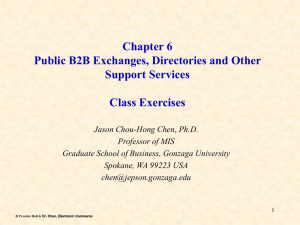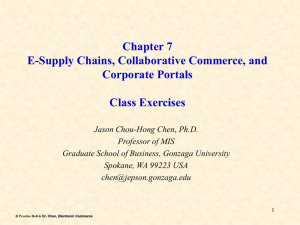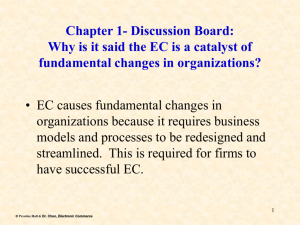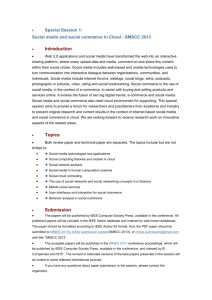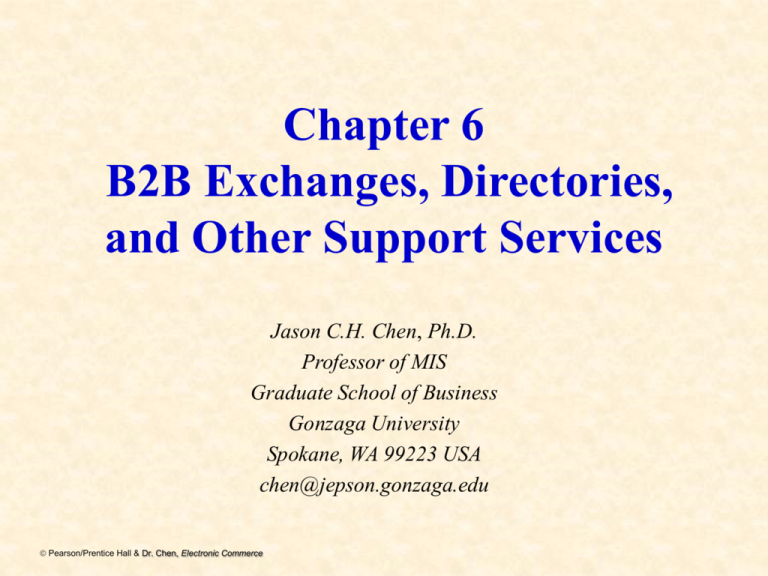
Chapter 6
B2B Exchanges, Directories,
and Other Support Services
Jason C.H. Chen, Ph.D.
Professor of MIS
Graduate School of Business
Gonzaga University
Spokane, WA 99223 USA
chen@jepson.gonzaga.edu
Pearson/Prentice Hall & Dr. Chen, Electronic Commerce
Learning Objectives
1. Define exchanges and describe their major
types.
2. Describe the various ownership and
revenue models of exchanges.
3. Describe B2B portals.
4. Describe third-party exchanges.
5. Distinguish between purchasing
(procurement) and selling consortia.
Pearson/Prentice Hall & Dr. Chen, Electronic Commerce
Learning Objectives
6. Define dynamic trading and describe B2B
auctions.
7. Describe partner relationship management
(PRM).
8. Discuss integration issues of e-marketplaces and
exchanges.
9. Discuss B2B networks.
10. Discuss issues in managing exchanges, including
the critical success factors of exchanges.
Pearson/Prentice Hall & Dr. Chen, Electronic Commerce
6.1 B2B Electronic Exchanges—
An Overview
• public e-marketplace (public exchange)
A many-to-many e-marketplace. Trading venues
open to all interested parties (sellers and buyers);
usually run by third parties. Some are also known
as trading exchanges
• market maker
The third party that operates an exchange (and in
many cases, also owns the exchange)
Pearson/Prentice Hall & Dr. Chen, Electronic Commerce
Exhibit 6.1 The Community of an Exchange:
Information Flow and Access to Information
Government
Professional
Association
Universities
Research Institutions
Manufacturers
Dealers
Contractors
Suppliers
Market Maker
and Administrator
Trading
Community
Customers
( An Exchange )
Retailers
Subsuppliers
Content
Providers
Banks
Financial
Institutions
Pearson/Prentice Hall & Dr. Chen, Electronic Commerce
Logistics
Services
IT Providers
Other
Exchanges
Exhibit 6.2 Classification of B2B Exchanges
Direct
Systematic
Sourcing
long-term
Spot
Sourcing
as needed
(1)
Vertical
Distributors
plastics.com
epapertrade.com
Methods: Aggregation,
fixed/negotiated prices
(3)
Vertical
Exchanges
Isteelasia.com
Chemconnect.com
Methods: Matching,
dynamic pricing
Pearson/Prentice Hall & Dr. Chen, Electronic Commerce
Indirect (MRO)
(2)
Horizontal
Distributors
mro.com
Methods: Aggregation,
fixed/negotiated prices
(4)
Horizontal
Exchanges
employease.com
Methods: Matching,
dynamic pricing
B2B Electronic Exchanges An Overview
• Vertical exchange: An exchange whose members
are in one industry or industry segment. It trades
only in materials/services unique for that industry
• Horizontal exchanges: Exchanges that handle
materials used by companies in different industries
• Dynamic pricing:
A rapid movement of prices over time, and possibly
across customers, as a result of supply and demand
Pearson/Prentice Hall & Dr. Chen, Electronic Commerce
N
B2B Electronic Exchanges (cont.)
•
The typical process that results in dynamic pricing in most
exchanges:
1. A company posts a bid to buy a product or an offer to sell one
2. An auction (forward or reverse) is activated
3. Buyers and sellers can see the bids and offers that usually remain
anonymous
4. Buyers and sellers interact with bids and offers in real time
Sometimes group purchasing is used to obtain a volume discount
price
5. A deal is struck when there is an exact match between a buyer and
a seller on price, volume, and other variables, such as location or
quality
6. The deal is consummated, and payment and delivery are arranged
Pearson/Prentice Hall & Dr. Chen, Electronic Commerce
B2B Electronic Exchanges (cont.)
• Functions of Exchanges
– Matching buyers and sellers
– Facilitating transactions
– Maintaining exchange policies and
infrastructure
Pearson/Prentice Hall & Dr. Chen, Electronic Commerce
Exhibit (Extra) Conventional Versus Exchange Processes
Conventional Process
Step 1
Step 2
Step 3
Request for
proposal
Buyer
Supplier K
Bidding
Bidding Sequence Repeated for k=1 to n
Evaluate,
Notify
Buyer
negotiate,
supplier
and accept
Proposal Evaluation and Acceptance
Good shipped
Payment
Buyers
Buyer
Transaction Completion
Exchange Process
Step 1
Buyer 1: RFP
Buyer 2: RFP
Buyer 3: RFP
Exchange
RFPs Submitted and Bids Made
Step 2
Buyer 1 :Best Bid
Buyer 1: Payment
Exchange
Best Bid Accepted
Source: Based on Brint.com. Copyright © by Brint Institute, LLC. All rights reserved.
Pearson/Prentice Hall & Dr. Chen, Electronic Commerce
Supplier A Bid
Supplier B Bid
Supplier C Bid
Supplier D Bid
Selected Supplier
Payment Less Commission
Logistics Services
General Purchasing Process
Forecast Demand
Request for Proposal/Quote (RFP/RFQ)
Bid
Supplier / Seller
Negotiate Contract
Process Orders
Shipping Orders
Receiving Orders
Invoicing
Payment
Vender Performance Tracking & Management
Customer Service
Pearson/Prentice Hall & Dr. Chen, Electronic Commerce
Buyer
Place Orders
B2B Electronic Exchanges (cont.)
• Ownership of Exchanges
– One company, usually an industry giant
– A neutral entrepreneur (a ‘third-party’
intermediary)
– The consortium (or “third-party” co-op)
• Governance and Organization
– Membership
– Site access and security
– Services provided by exchanges
Pearson/Prentice Hall & Dr. Chen, Electronic Commerce
B2B Electronic Exchanges (cont.)
• Advantages of Exchanges
– Making markets more efficient, providing
opportunities for sellers and buyers to find new
business partners
– Cutting the administrative costs of ordering
MROs
– Expediting trading processes
– Facilitating global trade
– Creating communities of informed buyers and
sellers
Pearson/Prentice Hall & Dr. Chen, Electronic Commerce
B2B Electronic Exchanges (cont.)
Pearson/Prentice Hall & Dr. Chen, Electronic Commerce
B2B Electronic Exchanges (cont.)
Pearson/Prentice Hall & Dr. Chen, Electronic Commerce
B2B Electronic Exchanges (cont.)
• Revenue models
1.
2.
3.
4.
5.
Transaction fees
Fee for service
Membership fees
Advertising fees
Other revenue
sources
N
Pearson/Prentice Hall & Dr. Chen, Electronic Commerce
6.2 B2B Portals and Directories
B2B Portals and Directories
• B2B portals: Information portals for businesses
• Vortals : B2B portals that focus on a single
industry or industry segment; “vertical
portals”
• Pure information portals include:
– directories of products offered by each seller
– lists of buyers and what they want
– other industry or general information
Pearson/Prentice Hall & Dr. Chen, Electronic Commerce
B2B Portals and Directories
• Directory Services and Search Engines
– Directory services can help buyers and sellers
manage the task of finding specialized
products, services, and potential partners
– Specialized search engines are becoming a
necessity in many industries due to the
information glut
Pearson/Prentice Hall & Dr. Chen, Electronic Commerce
B2B Portal Examples (cont.)
• Alibaba.com—started as a pure information portal
and is moving toward becoming a trading
exchange
– Huge database is a horizontal information portal with
offerings in a wide variety of product categories
– Reverse auctions (sellers bid)
– Features–free email, email alerts, legal information, etc.
– Revenue model—advertisement and fees for special
services
Pearson/Prentice Hall & Dr. Chen, Electronic Commerce
6.3 Third-Party
and Directory Exchanges
• Third-party exchanges are characterized by
two contradicting properties
– They are neutral because they do not favor
either sellers or buyers
– Because they do not have a built-in
constituency of sellers or buyers, they
sometimes have a problem attracting enough
buyers and sellers to attain financial viability
Pearson/Prentice Hall & Dr. Chen, Electronic Commerce
Third Party (Trading)
Exchanges (cont.)
• A major problem is:
– How to increase their financial viability
– Market liquidity: The degree to which
something can be bought or sold in a
marketplace without affecting its price
• Solution
– Team up with with partners such as large
sellers or buyers, financial institutions
Pearson/Prentice Hall & Dr. Chen, Electronic Commerce
N
Exhibit 6.6 Supplier Aggregation Model - Third Party (Trading) Exchanges
Small
Buyers (SMEs)
Suppliers
SME1
#1
#2
Aggregation of
Catalogs
(Commerce One)
Hosting
SME2
Workflow
applications
SME3
#3
Large
Buyers
#4
Workflow,
Approvals,
Budget controls
Pearson/Prentice Hall & Dr. Chen, Electronic Commerce
etc.
Buyer #1
ERP, SCM
Integration
Third Party (Trading)
Exchanges (cont.)
• Buyer aggregation model
buyers’ RFQs are aggregated and then linked to
a pool of suppliers that are automatically
notified of the RFQs (see next slide)
• Suitability
– aggregation models work best with MROs and
services that are well defined, that have stable
prices, and where the supplier or buyer base is
fragmented
Pearson/Prentice Hall & Dr. Chen, Electronic Commerce
N
Exhibit 6.7 Buyer Aggregation Model - Third Party (Trading) Exchanges
Buyers
Suppliers
#1
#1
GPO
#2
RFQ
#3
Suppliers’
offers
etc.
Requests
Response
Pearson/Prentice Hall & Dr. Chen, Electronic Commerce
Aggregating RFQs
from Suppliers;
collecting RFPs from
bidders, matching
(selecting offers)
Buyers’
requests
#2
#3
Bids
etc.
Group Purchasing Organization Process
[Stage1-b]
Forecast Demand
RFQ
Response
G
[Stage3]
Returns
P
Confirm
(Price OK)
B
...
RFQ
Bid
Negotiate Contract
Place Orders
Process Orders
Shipping Orders
Receiving Orders
Invoicing
Payment
VPTM
RFQ
u
[Stage2]
Shipping / Receiving Orders
y
…
…
S
u
p
p
l
i
e
r
/
S
e
l
l
e
r
[Stage1-a]
Refund Process
O
Shipping / Receiving Orders
Invoice
Payment
Returns
[Stage4]
Refund Process
VPTM : Vender Performance Tracking & Management
Pearson/Prentice Hall & Dr. Chen, Electronic Commerce
e
r
Third-Party
and Directory Exchanges
• market liquidity
The degree to which something can be
bought or sold in a marketplace without
significantly affecting its price. It is
determined by the number of buyers and
sellers in the market and the transaction
volume
Pearson/Prentice Hall & Dr. Chen, Electronic Commerce
BREAK-1
• Application Case 6.2: Global
Transportation Network Ocean Portal (p.272)
Pearson/Prentice Hall & Dr. Chen, Electronic Commerce
6.4 Consortium Trading
Exchanges
•
•
Consortium trading exchange (CTE): An
exchange formed and operated by a group of
major companies to provide industry-wide
transaction services
Markets operate in three basic types of
environments:
1. Fragmented markets
2. Seller-concentrated markets
3. Buyer-concentrated markets
Pearson/Prentice Hall & Dr. Chen, Electronic Commerce
N
Consortium Trading Exchanges
(cont.)
•
CTEs, defined by two main criteria:
–
–
•
whether they focus on buying or selling
whether they are vertical or horizontal
4 types of CTEs
1.
2.
3.
4.
Purchasing oriented, vertical
Purchasing oriented, horizontal
Selling oriented, vertical
Selling oriented, horizontal
Pearson/Prentice Hall & Dr. Chen, Electronic Commerce
V
H
P
1
2
S
3
4
Consortium Trading Exchanges
(cont.)
• Purchasing-oriented (procurement)
consortia
– Vertical Purchasing-Oriented CTEs
all the players are in the same industry
– Horizontal Purchasing-Oriented CTEs
• owner-operators are large companies from
different industries that unite for the purpose of
improving the supply chain of MROs used by
most industries
Pearson/Prentice Hall & Dr. Chen, Electronic Commerce
N
Consortium Trading Exchanges
(cont.)
• Selling-oriented consortia
– Selling-oriented consortia are less common
than buying-oriented ones.
– Most selling-oriented consortia are vertical
– Participating sellers have thousands of potential
buyers within a particular industry
Pearson/Prentice Hall & Dr. Chen, Electronic Commerce
Consortium Trading Exchanges
(cont.)
• Other issues for consortia
– Legal challenges for B2B consortia
• level of collaboration among both competitors and
business partners
• antitrust and other competition laws must be
considered
– Critical success factors for consortia
• Appropriate business and revenue models
• Size of the industry
• Ability to drive user adoption
Pearson/Prentice Hall & Dr. Chen, Electronic Commerce
Consortium Trading Exchanges
(cont.)
• Elasticity
The measure of the incremental spending by buyers as
a result of the savings generated
• Standardization of commodity-like products
• Management of intensive information flow (collaboration)
• Smoothing of supply chain inefficiencies
– Combining consortia and third-party exchanges
• dot-consortia - large consortia + third-party owner
• combination may bring about the advantage of both
ownership and minimizing third-party limitations such as
low liquidity
Pearson/Prentice Hall & Dr. Chen, Electronic Commerce
N
6.5 Dynamic Trading:
Matching and Auctions
• dynamic trading
Trading that occurs in situations when
prices are changing continuously, being
determined by supply and demand (e.g., in
auctions)
Pearson/Prentice Hall & Dr. Chen, Electronic Commerce
Dynamic Trading:
Matching and Auctions
• Matching
– The matching process may be more complex
than buying and selling in regular auctions due
to the need to match both prices and quantities,
and many cases, quality, delivery times, and
locations
• Auctions
– An exchange may offer auction services as one
of its many activities
– An exchange is fully dedicated to auctions
Pearson/Prentice Hall & Dr. Chen, Electronic Commerce
Dynamic Trading: Matching and Auctions
EXHIBIT 6.9 Comparing the Major B2B Many-to-many Models
Name
B2B catalogbased
exchanges
B2B portals
B2B
dynamic
exchange
Major Characteristics
• A place for selling and buying
• Fix prices ( updated as needed)
• Search tools
• Trading information
• Community services, news, information
• Communication tools
• Classified ads
• Employment Markets
• May support selling (buying)
• Fixed prices
• M ay do auctions
• Matches buyer/seller other at dynamic prices,
auctions
• Provides trading-related information and
services (payment, logistics)
• Highly related
• May provide general information, news, etc.
• May provide for negotiations
Pearson/Prentice Hall & Dr. Chen, Electronic Commerce
Types
Vertical, horizontal
•Shopping directory, usually
with hyperlinks (only)
•Shopping carts with services
(payment, etc.)
Vertical (vortals), horizontal
•Shopping directory,
usually with hyperlinks
Vertical, horizontal
•Forward auctions
•Reverse auctions
•Bid/ask exchanges
6.6 Partner and Supplier
Relationship Management
• partner relationship management (PRM)
Business strategy that focuses on providing
comprehensive quality service to business partners
• supplier relationship management (SRM)
A comprehensive approach to managing an
enterprise’s interactions with the organizations that
supply the goods and services it uses
Pearson/Prentice Hall & Dr. Chen, Electronic Commerce
Partner and Supplier
Relationship Management
Note: PeopleSoft is now
owned by Oracle
Pearson/Prentice Hall & Dr. Chen, Electronic Commerce
The Wal-Mart Supply Chain
4
3-a
1-c
1-a
3-b
1-b
2-b
2-a
Pearson/Prentice Hall & Dr. Chen, Electronic Commerce
Partner and Supplier
Relationship Management
• E-Communities and PRM
– B2B applications involve many participants: buyers and
sellers, service providers, industry associations, and
others, which creates a community
– E-communities connect personnel, partners, customers,
and any combination of the three
– E-communities offer a powerful resource for ebusinesses to leverage online discussions and
interaction in order to maximize innovation and
responsiveness
Pearson/Prentice Hall & Dr. Chen, Electronic Commerce
6.7 Building and Integrating
E-Marketplaces and Exchanges
• Building E-Marketplaces
– Building e-marketplaces is a complex process
– usually performed by a major B2B software
company
•
•
•
•
Commerce One
Ariba
Oracle
IBM
Pearson/Prentice Hall & Dr. Chen, Electronic Commerce
Building and Integrating
E-Marketplaces and Exchanges
• Integration issue
– Seamless integration is needed between the
third-party exchange and the participants’ front
and back-office systems
– In private exchanges the seller’s computing
system must be integrated with the customers
systems
Web-based Systems
Pearson/Prentice Hall & Dr. Chen, Electronic Commerce
Four most common elements of B2B
Integration Solutions
1. External communications
•
•
•
•
Web/client access
Data exchange
Direct application integration
Shared procedures
2. Process and information coordination in
integration
how to coordinate external communications
with internal information systems
Pearson/Prentice Hall & Dr. Chen, Electronic Commerce
N
Four most common elements of B2B
Integration Solutions (cont.)
3. Use of Web services in integration
Web Services enable different Web-based
systems to communicate with each other using
Internet-based protocols such as XML
4. System and information management in
integration
management of software, hardware, and several
information components, including partner-profile
information, data and process definitions,
communications and security settings, and users’
information
Pearson/Prentice Hall & Dr. Chen, Electronic Commerce
N
6.8 B2B Networks
• Private Marketplaces
– E-marketplaces that are owned and operated by
one company. Also known as company-centric
marketplaces
Pearson/Prentice Hall & Dr. Chen, Electronic Commerce
6.8 B2B Networks
• Characteristics of Company-Centered (Private)
Networks
– Provide the infrastructure for e-marketplaces
– Allow suppliers to communicate effectively and efficiently with
sub-suppliers along several tiers
– Increase the visibility of buyers, sellers, and other partners along
the supply chain and around the globe
– Operate on a large scale
– Foster collaboration and closer relationships among business
partners
– Enable industry-wide resource planning
– Provide support services, especially financial ones for the benefit
of trading partners
– Provide insurance, financial derivatives, and so on to reduce risks
in certain markets
e.g., Boeing’s PART – connects Boeing’s customers to Boeing and
Boeing’s parts suppliers.
Pearson/Prentice Hall & Dr. Chen, Electronic Commerce
B2B Networks –Boeing’s Example
• B2B intermediary: Boeing’s parts marketplace
– World’s largest maker of airplanes for commercial and
military customers
– Major goal of Boeing’s intermediary parts market,
called PART is supporting customers’ maintenance
needs as a customer service
– Online strategy is to provide a single point of online
access through which airlines (buyers) and the
maintenance and parts providers (suppliers) can access
data about the parts they need
– Began using traditional EDI
Pearson/Prentice Hall & Dr. Chen, Electronic Commerce
B2B Networks –Boeing’s Example (cont.)
– 1996, Boeing introduced its PART page on
the Internet
– Customers around the world could
• check parts availability and pricing
• order parts
• track order status
– Less than a year later, about 50 percent of
Boeing’s customers used PART for parts
orders and customer service inquiries
Pearson/Prentice Hall & Dr. Chen, Electronic Commerce
B2B Networks –Boeing’s Example (cont.)
– Boeing OnLine Data (BOLD) enables
mechanics and technicians at the airport to
access the technical manuals they need for
repairs
– These manuals are now available in digital
form, and mechanics and technicians can access
them via wireline or wireless devices
Pearson/Prentice Hall & Dr. Chen, Electronic Commerce
B2B Networks
• Public Industrywide (Vertical) Networks
• Transindustry And Global Networks
– Networks of exchanges (E2E)
– Global networks
Pearson/Prentice Hall & Dr. Chen, Electronic Commerce
B2B Networks
Pearson/Prentice Hall & Dr. Chen, Electronic Commerce
6.9 Other B2B Implementation
Issues
•
Problems with public exchanges
1.
2.
3.
4.
5.
Transaction fees : required to pay transaction fees
with existing customers
Sharing information: do not want to share business
data with competitors
Cost savings : not great enough to attract buyers
Recruiting suppliers: lose direct contact with
customers
Too many exchanges
Pearson/Prentice Hall & Dr. Chen, Electronic Commerce
N
Other B2B Implementation Issues
• Supply chain improvers
– Companies want to streamline their internal
supply chains, which requires integration with
internal operations instead of “plugging in” to
an exchange’s infrastructure
• Problems with private exchanges
– Major problem is trust in the (one) large
corporation running the exchange
Pearson/Prentice Hall & Dr. Chen, Electronic Commerce
Other B2B Implementation Issues
• Software Agents in B2B Exchanges
– Software agents provide an efficient
infrastructure to provide real-time, tighter
integration between buyers and sellers and to
facilitate management of multiple trading
partners and their transactions across multiple
virtual industry exchanges
• Disintermediation and Reintermediation
Pearson/Prentice Hall & Dr. Chen, Electronic Commerce
Value-added Services
• Once a critical mass is reached, exchanged
operators must expand the services they provide to
users.
• Value-added services can make an exchange even
more compelling:
–
–
–
–
Industry news, expert advice
Auctions, financial services
Business reporting, data mining
Detailed specification sheets
Pearson/Prentice Hall & Dr. Chen, Electronic Commerce
6.10 Managing and the
Future of Exchanges
•
•
•
Evaluating Exchanges
Centralized Management
Critical Success Factors for Exchanges
1.
2.
3.
4.
5.
Early liquidity
The right owners
The right governance
Openness
A full range of services
Pearson/Prentice Hall & Dr. Chen, Electronic Commerce
Managing and the
Future of Exchanges
• New Directions for B2B Marketplaces
– Critical success factors for exchanges
•
•
•
•
•
•
•
•
•
•
Importance of domain expertise
Targeting inefficient industry processes
Targeting the right industries
Brand building
Exploiting economies of scope
Choice of business/revenue models
Blending content, community, and commerce
Managing channel conflict
Maximize the benefits for all participants
Other factors
Pearson/Prentice Hall & Dr. Chen, Electronic Commerce
Managerial Issues
1.
2.
3.
4.
5.
6.
Have we done our homework?
Can we use the Internet?
Which exchange to join?
Will joining an exchange force restructuring?
Will we face channel conflicts?
What are the benefits and risks of joining an
exchange?
7. Can we trust new trading partners?
Pearson/Prentice Hall & Dr. Chen, Electronic Commerce
BREAK-2
• Application Case 6.3: Asite’ B2B EMarketplace for the Construction Industry
(p.289)
Pearson/Prentice Hall & Dr. Chen, Electronic Commerce


